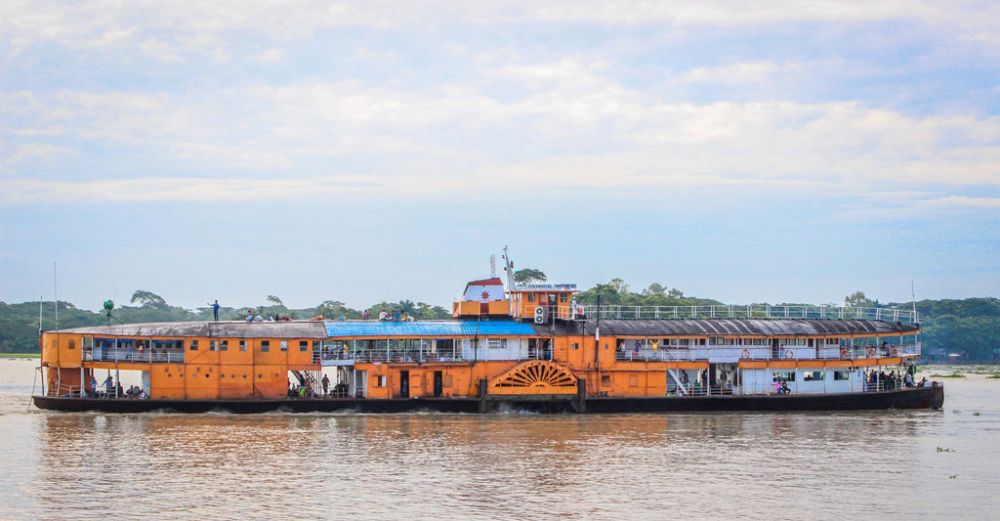paddlesteamers.info : The Internet's leading website for Side-Wheeled Paddle Steamers
Paddlers (originally steamers, but converted to diesel power in 1995) still exist in Bangladesh. Until 2022 they were operated by Bangladesh Inland Water Transport Corporation on the famous "Rocket" service from Dhaka (Sadarghat Ferry terminal) to Morrelganj with various intermediate stops, a distance of 354 kilometres. The route tooks the vessels along several rivers in the Padma delta and included calls at Chandpur, Barisal, Hularhat. Originally the service went as far as Khulna.
The
situation changed with the opening of a new bridge over the Padma at
Louhajang in June 2022. This enormous infrastructure project has
transformed accessibility from the south-western delta area to Dhaka,
the nation's capital city. The loss-making Rocket service suffered a
loss of patronage and it was decided to lay the vessels up pending a
decision about their future. The authorities are keen to keep the
classic vessels in some service and made them available for bids from
private operators to use them on tourist excursions, although it has
been indicated that the state operators wish to retain Mahsud and
operate tours with her.
As of January 2024 :
OSTRICH : has been leased to a private operator and is under renovation
TERN : is tied up at Narayanganj ghat on the Bhuiganga river at Narayanganj, near Dhaka
MAHSUD : is tied up at Badamtali Rocket ghat on the Bhuiganga River at Dhaka
LEPCHA: is tied up at Badamtali Rocket ghat on the Bhuiganga River at Dhaka
Above : MPV (ex-steamer) Mahsud of 1929 serving on the "Rocket" line.
Photo from wikicommons by A Rahim, reproduced under Creative Commons licence : https://creativecommons.org/licenses/by-sa/4.0/deed.en
The "Rocket" Serevice
There were four "classic" vessels in service on this route, Mahsud, Ostrich, Tern and Lepcha in its final years. All were built and engined by Denny of Dumbarton, Scotland, however their steam engines have been replaced with diesel engines. Details of original engines are included below
Mahsud (1929)
----- Builder's yard no 1227 for the Rivers Steam Navigation Co : 235 ft x 30 ft x 9 ft - Triple expansion diagonal 41 in, 25.5 in, 16 in x 63 in - engine no 977.Ostrich (1929)
----- Builder's yard no 1228 for the India General Navigation Co : 235 ft x 30 ft x 9 ft - Triple expansion diagonal 41 in, 25.5 in, 16 in x 63 in - engine no 978Lepcha (1937)
----- Builder's yard no 1318 for the Rivers Steam Navigation Co : 190 ft x 25 ft x 8,6 ft, Triple expansion diagonal 41 in 25,5 in, 16 in x 54 in - engine no 1073
Tern (1948/9)
----- Builder's yard no 1419 for the India General Navigation Co : 200 ft x 26 ft x 8.6 ft - Triple expansion diagonal 41 in, 25.5 in, 16 in x 54 in - engine no 1165
Vessels offer accommodation in three classes and are patronised by regular paying ferry passengers and tourists sailing as part of organised holiday tours. Only in First Class, on the upper deck forward, do the cabins have a wash basin and bed linen and on deck there is dining and tea service with stewards in attendance. Sailing "Deck class" is altogether different. Passengers have to bring their own sleeping bag and sleep on the deck. The journey passes through the Sundarbans, the vast mangrove Forest of the Padma delta which is teeming with exotic wildlife. (see BBC report on this link). For 2018 the advertised schedule shows paddlers leaving Dhaka at 06:30 every day except Friday, arriving at 14:30 hrs the following day. The return is at 08:30 hrs, daily exept Sunday, arriving at 05:00 hrs on the following morning.
These old ships remain on this flagship passenger service as the operators are constantly short of new vessels due to financial constraints. The ships are not fully reliable and lack of availablity is often compounded by ships being out of service due to damage sustained on the river, either at river banks or on sandbanks - the rivers are notoriously dangerous, especially during cyclone weather and is susceptible to flooding. Also, being a busy waterway, there are frequent tragedies due to collisions and capsising of overcrowded ferries. Whilst these vessels have survived the tribulations and are amongst the safest in operation, one recent example shows how serious these incidents can be :Return to